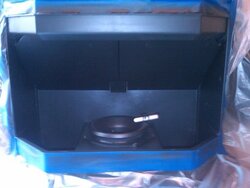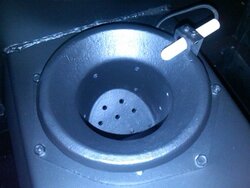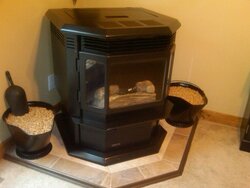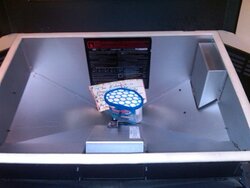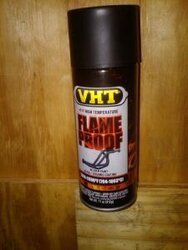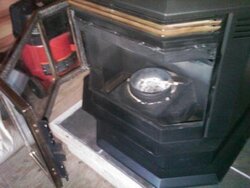I have a Santa Fe that I just painted (inside) with Rustoleum High Heat (2000 degrees). I was surprised how nice it turned out. However in my haste I realized that the paint was not flame resistant. What will happen to the paint on my first burn? I am assuming it will peel and burn off. If so, can I apply a coat of flame resistant paint (Stove Bright perhaps) over the Rustoleum before my first burn?
Proper Paint For Inside Of Stove
- Thread starter gerryger
- Start date
-
Active since 1995, Hearth.com is THE place on the internet for free information and advice about wood stoves, pellet stoves and other energy saving equipment.
We strive to provide opinions, articles, discussions and history related to Hearth Products and in a more general sense, energy issues.
We promote the EFFICIENT, RESPONSIBLE, CLEAN and SAFE use of all fuels, whether renewable or fossil.
You are using an out of date browser. It may not display this or other websites correctly.
You should upgrade or use an alternative browser.
You should upgrade or use an alternative browser.
- Status
- Not open for further replies.
I
imacman
Guest
gerryger said:..... If so, can I apply a coat of flame resistant paint (Stove Bright perhaps) over the Rustoleum before my first burn?
I don't see why not.
D
DexterDay
Guest
It will soon burn off also. Not designed for internal use. Even the High Heat BBQ paint says external only. I painted my stove on the inside too. But I know it wont last long. I intend on painting it every Spring at Spring Cleaning time. Looks good for the Summer. Then just burn it in the Winter.
gerryger said:So am I to assume that there are no paints available that will last throughout the heating season.
You assume right. They all will burn off the first time you fire that puppy up.
D
DexterDay
Guest
BrotherBart said:gerryger said:So am I to assume that there are no paints available that will last throughout the heating season.
You assume right. They all will burn off the first time you fire that puppy up.
Yep. Internal paint does not last. Thats why you are painting it now. Add 1,000* (flame is hotter than that) heat and ash (corrosive) and you have rust. Every year you should do your Sprinv Cleaning and P.M.'s.
dmaclaren
Member
D
DexterDay
Guest
dmaclaren said:I used 2000 degree paint of my inside. I ran it a couple times ans it has lasted just fine.
A couple of times??? Equates to how many total hours. After 168 hrs or 7 days of Straight burning. That paint will be toast. A few hrs is no test.
Did my stove this year. After a week. It will be toast. Internal temps and the ash eat anything in the firebox.
Paint it every Spring to make it look good. You'll be fine.
Attachments
mepellet
Minister of Fire
krooser
Minister of Fire
mepellet said:What should you do then instead of painting to prevent rust inside the stove?
Spray a little WD40 on it and call it good...I don't worry about a little rust. Doesn't affect anything. My stove is 10 years old and has never been babied and it works just fine.
ChandlerR
Minister of Fire
This leads to a question. My partner at work has an Avalon and his theory is to leave the stove uncleaned for the Summer then do a complete teardown in the Fall. His thought is the soot keeps the moisture off the metal. When I helped him clean it last week, it certainly looked good under the soot we removed. Even the hard, baked on stuff, came off easily. Does it matter, I wonder?
Chan
Chan
D
DexterDay
Guest
Ash and soot absorb moisture. Which makes things worse. Always better to clean it in the Spring when its still fresh in your mind.CWR said:This leads to a question. My partner at work has an Avalon and his theory is to leave the stove uncleaned for the Summer then do a complete teardown in the Fall. His thought is the soot keeps the moisture off the metal. When I helped him clean it last week, it certainly looked good under the soot we removed. Even the hard, baked on stuff, came off easily. Does it matter, I wonder?
Chan
As for protecting. Pam cooking spray is better than WD-40. You can ise it or paint it. I never said not to paint it. Just wouldnt go out of my way for High Temp (for inside the stove) Inside is a harsh environment.
It took jusg a few minutes of prep (tape and plastic as seen in the pics from my previous post) and I also used my leaf blower. I ran the leaf blowed while spray painting, which took all the overspray and fumes out of the house. For the 10-15 minutes of time it took, I will continue to do this every year. My stove looks as good as the day I installed it.
Oh and I also put a Damp Rid in ths hopper and the ash pan. To help absorb any moisture that may get in. Along with plugging the exhaust and OAK. No humidity, no moisture, no rust = great looking stove that will last many years longer. Remember rust eats steel. It may take 15 yrs but the next owners will appreciate what I did and I will probably be able to sell it for more than a stove thats all rusty and nasty.
Attachments
ChandlerR
Minister of Fire
That makes sense, Dexter. I will let him know your thoughts tomorrow at work. I think blocking the OAK is a big factor, especially where we live so close to the ocean. I put a soft rubber ball in mine that effectively blocks it off and doesn't look bad from the outside.
Hello
I use VHT Flame proof 2,000 Degree F Header Paint for car exhaust headers from Pep Boys Auto Parts. It seems to work very well! see pic below.
This Paint is Flame Proof and will NOT burn off. They use it on JET Engines!! See pic Below:
http://www.vhtpaint.com/products/flameproof/
VHT FLAMEPROOFâ„¢ COATING
VHT FlameProof™ Coating will renew and extend the life of any surface exposed to extremely high temperatures. This unique coating is a matte finish, silicone ceramic base widely used by the automotive industry on exhaust systems and the aerospace industry for jet engines, re-entry vehicles and other high temperature applications. VHT FlameProof™ Coating will withstand temperatures up to 2000°F (1093°C) and is ideal for use on headers, exhaust systems, or wherever an extreme temperature coating is needed.
Temperature: 1300°F-2000°F (704°C-1093°C)
Applications: Headers, Exhaust Manifolds, Piston Domes, Inside Heads
Finish: Flat
Dry Time: Curing time required and can be done on or off vehicle (see below)
Curing FlameProofâ„¢
VHT FlameProofâ„¢ Coating only attains its unique properties after correct curing (refer to instructions on the can).
On the Vehicle
Paint must be completely dry before curing
Run at idle for 10 minutes
Cool for 20 minutes
Run at idle for 20 minutes
Cool for 20 minutes
Run under normal operating conditions for 30 minutes
Off the Vehicle
Paint must be completely dry before curing
Heat to 250°F (121°C) for 30 minutes
Cool for 30 minutes
Heat to 400°F (204°C) for 30 minutes
Cool for 30 minutes
Heat to 650°F (343°C ) for 30 minutes
Caution: Do not exceed the temperature of the least heat tolerant component or the base metal
Coating System
VHT provides a multi-high performance coating system for the ultimate in protection and quality. The system includes surface preparation, primer, paint and clear coat.
Prep SP445 Prep Spray
Prime SP118 FlameProofâ„¢ Primer
Coat SPXXX FlameProofâ„¢ Color
Finish SP115 FlameProofâ„¢ Clear
I use VHT Flame proof 2,000 Degree F Header Paint for car exhaust headers from Pep Boys Auto Parts. It seems to work very well! see pic below.
This Paint is Flame Proof and will NOT burn off. They use it on JET Engines!! See pic Below:
http://www.vhtpaint.com/products/flameproof/
VHT FLAMEPROOFâ„¢ COATING
VHT FlameProof™ Coating will renew and extend the life of any surface exposed to extremely high temperatures. This unique coating is a matte finish, silicone ceramic base widely used by the automotive industry on exhaust systems and the aerospace industry for jet engines, re-entry vehicles and other high temperature applications. VHT FlameProof™ Coating will withstand temperatures up to 2000°F (1093°C) and is ideal for use on headers, exhaust systems, or wherever an extreme temperature coating is needed.
Temperature: 1300°F-2000°F (704°C-1093°C)
Applications: Headers, Exhaust Manifolds, Piston Domes, Inside Heads
Finish: Flat
Dry Time: Curing time required and can be done on or off vehicle (see below)
Curing FlameProofâ„¢
VHT FlameProofâ„¢ Coating only attains its unique properties after correct curing (refer to instructions on the can).
On the Vehicle
Paint must be completely dry before curing
Run at idle for 10 minutes
Cool for 20 minutes
Run at idle for 20 minutes
Cool for 20 minutes
Run under normal operating conditions for 30 minutes
Off the Vehicle
Paint must be completely dry before curing
Heat to 250°F (121°C) for 30 minutes
Cool for 30 minutes
Heat to 400°F (204°C) for 30 minutes
Cool for 30 minutes
Heat to 650°F (343°C ) for 30 minutes
Caution: Do not exceed the temperature of the least heat tolerant component or the base metal
Coating System
VHT provides a multi-high performance coating system for the ultimate in protection and quality. The system includes surface preparation, primer, paint and clear coat.
Prep SP445 Prep Spray
Prime SP118 FlameProofâ„¢ Primer
Coat SPXXX FlameProofâ„¢ Color
Finish SP115 FlameProofâ„¢ Clear
Attachments
- Status
- Not open for further replies.
Similar threads
- Replies
- 25
- Views
- 891
- Replies
- 3
- Views
- 999
- Replies
- 11
- Views
- 3K
- Replies
- 24
- Views
- 776
- Replies
- 29
- Views
- 3K


